Moths -
More Information |
|
|
|
~ Click on any image for an enlargement - scrollable if it is too big for browser window ~
|
Kingdom: Animalia
Phylum: Arthropoda
Subphylum: Hexapoda
Class: Insecta Pterygota
Order: Lepidoptera
|
|
Agreeable Tiger Moth
Spilosoma congrua
Superfamily: Noctuoidea
Family: Tiger Moths Arctiidae
Subfamily: Tiger Moths Arctiinae
Tribe: Arctiini

|
- Identification: Pure white and nearly identical to the Pink-legged Tiger Moth (Spilosoma latipennis), but coxa and femur of the foreleg are yellow, not pink. Some specimens have black spots in pm. and st. areas of forewing.
- Life history: Not reported
- Flight: April-August.
- Wing span: 2.7-4.7 cm.
- Caterpillar hosts: Herbaceous plants, including dandelions and pigweed. Larva has also been seen boring into mushroom stems.
- Adult food: Not reported
- Habitat: Not reported
- Range: Throughout eastern North America.
|
Ailanthus Webwing Moth
Atteva punctella
Superfamily: Yponomeutoidea
Family: Ermine Moths Yponomeutidae
Subfamily: Tropical Ermine Moths Attevinae
Tribe: Lasiocampini
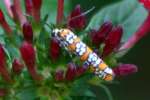 |
|
Azalea Sphinx Moth
Darapsa choerilus
Superfamily: Bombycoidea
Family: Sphingidae Sphinx Moths
Subfamily: Macroglossinae
Tribe: Macroglossini
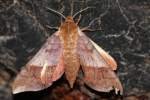
|
|
|
Banded Tussock Moth
Halysidota tessellaris
Superfamily: Noctuoidea
Family: Tiger Moths Arctiidae
Subfamily: Tiger Moths Arctiinae
Tribe: Arctiini
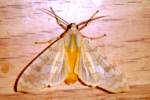
|
 |
|
Carolina Sphinx Moth
Manduca sexta
Superfamily: Bombycoidea
Family: Sphingidae - Sphinx Moths, Hawkmoths
Subfamily: Sphinginae
Tribe: Sphingini
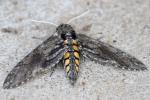
|
|
Carpenterworm Moth
Prionoxystus robiniae
Superfamily: Cossoidea
Family: Cossidae Carpenter and Leopard Moths
Subfamily: Cossinae
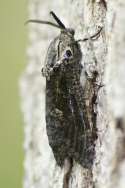
|
|
Common Looper Moth
Autographa precationis
Superfamily: Noctuoidea
Family: Owlet Moths, Miller Moths Noctuidae
Subfamily: Plusiines Plusiinae
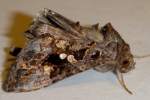
|
|
Common Lytrosis Moth
Lytrosis unitaria
Superfamily: Geometroidea
Family: Geometridae Geometrid Moths
Subfamily: Ennominae
Tribe: Angeronini
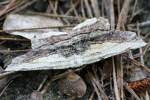
|
 |
Common Ptichodis Moth
Ptichodis herbarum
Superfamily: Noctuoidea
Family: Erebidae
Subfamily: Catocalinae
Tribe: Euclidiini
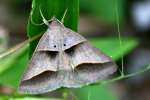
|
|
Copper Underwing Moth
Amphipyra pyramidoides
Superfamily: Noctuoidea
Family: Noctuidae Owlet Moths
Subfamily: Amphipyrinae
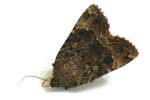
|
|
|
Corn Earworm Moth
Helicoverpa zea
Superfamily: Noctuoidea
Family: Noctuidae Owlet Moths
Subfamily: Heliothinae
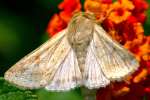
|
- Identification: Forewing yellowish tan with variable reddish brown, olive green, or gray markings and shading. Reniform spot usually filled with dark gray. Hindwing whitish with dark gray veins and border, with surrounds whitish patch at midpoint of outermargin.
- Life history: Not reported
- Flight: May - December, several broods.
- Wing span: 3.2-4.5 cm.
- Caterpillar hosts: Larva (Corn Earworm or Bollworm or Tomato Fruitworm) is a pest of corn, cotton, tomato, and tobacco. The caterpillar feeds on the outer end of the ear beneath the husk.
- Adult food: Not reported
- Habitat: Not reported
- Range: Widespread.

|
|
Cranberry Girdler Moth
Chrysoteuchia topiaria
Superfamily: Pyraloidea
Family: Crambidae
Subfamily: Crambinae
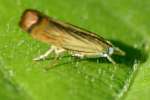
|
|
Cross-lined Wave Moth
Calothysanis amaturaria
Superfamily: Geometroidea
Family: Geometridae Geometrid Moths
Subfamily: Sterrhinae
Tribe: Timandrini
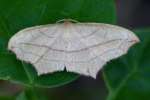
|
 |
|
Curve-toothed Geometer Moth
Eutrapela clemataria
Superfamily: Geometroidea
Family: Geometridae Geometrid Moths
Subfamily: Ennominae
Tribe: Ourapterygini
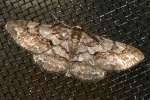
|
|
|
-- Moth
Cymatophora approximaria
Superfamily: Geometroidea
Family: Geometridae Geometrid Moths
Subfamily: Ennominae
Tribe: Angeronini
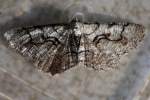
|
|
Distinguished Colomychus Moth
Colomychus talis
Superfamily: Pyraloidea
Family: Crambidae Crambid Snout Moths
Subfamily: Pyraustinae
Tribe: Spilomelini
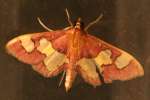
|
 |
|
-- Moth
Dolichomia olinalis
Superfamily: Pyraloidea
Family: Pyralid Moths Pyralidae
Subfamily: Pyralinae
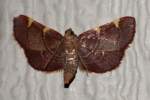
|
- Identification: Similar to Hypsopygia costalis, but slightly larger. Ground color varies from rose to deep purplish. Widened tops of am. and pm. lines more triangular. Yellow fringes on all wings, but narrower.
- Life history: Not reported
- Flight: May-September.
- Wing span: 1.6-2.4 cm.
- Caterpillar hosts: Oaks.
- Adult food: Not reported
- Habitat: Not reported
- Range: Throughout eastern North America.
|
|
Dot-lined Wave Moth
Idaea tacturata
Superfamily: Geometroidea
Family: Geometridae Geometrid Moths
Subfamily: Sterrhinae
Tribe: Sterrhini
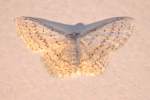
|
|
Eastern Grass-veneer Moth
Crambus laqueatellus
Superfamily: Pyraloidea
Family: Crambidae Crambid Snout Moths
Subfamily: Crambinae Crambine Snout Moths
Tribe: Crambini
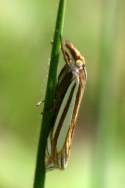
|
 |
Eastern Tent Caterpillar Moth
Malacosoma americanum
Superfamily: Lasiocampoidea
Family: Tent Caterpillar and Lappet Moths Lasiocampidae
Subfamily: Lasiocampinae
Tribe: Lasiocampini

|
|
Exposed Bird Dropping Moth
Acontia aprica
Superfamily: Noctuoidea
Family: Noctuidae Owlet Moths
Subfamily: Acontiinae
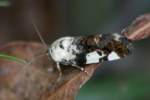
|
|
|
Fall Webworm Moth
Hyphantria cunea
Superfamily: Noctuoidea
Family: Tiger Moths Arctiidae
Subfamily: Tiger Moths Arctiinae
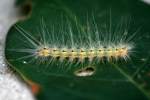
|
 |
Giant Leopard Moth
Hypercompe scribonia
Superfamily: Noctuoidea
Family: Tiger Moths Arctiidae
Subfamily: Tiger Moths Arctiinae
Tribe: Arctiini
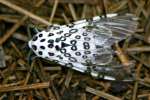 |
|
|
Glossy Black Idia Moth
Idia lubricalis
Superfamily: Noctuoidea
Family: Erebid Moths (Erebidae)
Subfamily: Herminiines (Herminiinae)
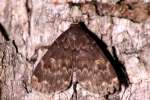
|
|
Grape Leaffolder Moth
Desmia funeralis
Superfamily: Noctuoidea
Family: Crambid Snout Moths Crambidae
Subfamily: Pyraustinae
Tribe: Spilomelini
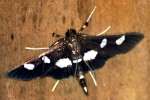 |
 |
|
Groundsel Plume Moth
Hellinsia balanotes
Superfamily: Pterophoroidea
Family: Pterophoridae (Plume Moths)
Subfamily: Pterophorinae
Tribe: Pterophorini
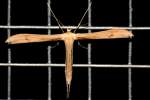
|
|
|
Green Cloverworm Moth
Hypena scabra
Superfamily: Noctuoidea
Family: Erebid Moths Erebidae
Subfamily: Hypenines Hypeninae
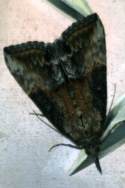
|
|
|
The Half-Yellow Moth
Ponometia semiflava
Superfamily: Noctuoidea
Family: Owlet Moths, Miller Moths Noctuidae
Subfamily: Acontiinae
Tribe: Acontiini
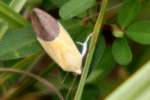
|
- Identification: Thorax and basal area of forewing solid yellow. Rest of forewing brown, sometimes with violet tinge. Hingwing shiny light yellowish to grayish brown.
- Life history: Not reported
- Flight: Not reported
- Wing span: 1.4-2.4 cm.
- Caterpillar hosts: Not reported
- Adult food: Not reported
- Habitat: Not reported
- Range: Not reported

|
Hawaiian Beet Webworm Moth
Spoladea recurvalis
Superfamily: Pyraloidea
Family: Crambidae Crambid Snout Moths
Subfamily: Pyraustinae
Tribe: Spilomelini
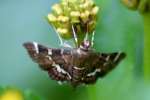 |
|
Hebrew Moth
Polygrammate hebraeicum
Superfamily: Noctuoidea
Family: Owlet Moths Noctuidae
Subfamily: Acronictinae
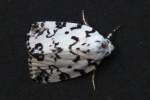
|
|
|
-- Moth
Hemileuca peigleri
Superfamily: Bombycoidea
Family: Giant Silkworm and Royal Moths / Wild Silk Moths Saturniidae
Subfamily: Buck & Io Moths Hemileucinae
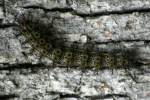
|
- Identification: Male abdomen is black with a red tip, female abdomen is black. Wings are almost transparent. Upperside is gray with narrow black borders and black wing bases. Each wing has a wide white band and a small eyespot.
- Life history: Males fly near the ground, but females fly 10-20 feet high in the oak trees. Adults emerge in the morning and mating takes place in early afternoon. In the late afternoon, females lay groups of eggs in rings around twigs of the host tree. The eggs overwinter, and when they hatch in February or March the young caterpillars feed in groups. Caterpillars wander about and in May or June make their cocoons in leaf litter on the ground or a few inches underground in soft soil.
- Flight: One brood from November-December.
- Wing span: 2 5/16 - 3 1/4 inches (5.8 - 8.2 cm).
- Caterpillar hosts: Texas live oak (Quercus fusiformis), Havard\'s oak (Q. havardii), Shumard's oak (Q. shumardii), and Nuttall oak (Q. texana).
- Adult food: Adults do not feed.
- Habitat: Oak-covered hills.
- Range: Central Texas.

|
Imperial Moth
Eacles imperialis
Superfamily: Bombycoidea
Family: Giant Silkworm and Royal Moths / Wild Silk Moths Saturniidae
Subfamily: Royal Moths Ceratocampinae
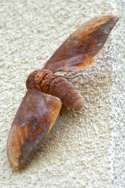
|
- Identification: Females are larger than males. Upperside is yellow with pinkish brown to purple-brown patches, bands, and cell spots, and tiny brown spots scattered overall. Males have larger patches on the forewings than females, except for some subspecies pini males which have reduced purple and are mostly yellow.
- Life history: Adults emerge before sunrise and mate after midnight the next day. Females lay eggs at dusk singly or in groups of 2-5 on both surfaces of host plant leaves. The eggs hatch in about 2 weeks, and the caterpillars are solitary feeders. Pupation takes place in underground burrows.
- Flight: One brood; in the north from June-August, in the south from April-October.
- Wing span: 3 1/8 - 6 7/8 inches (8 - 17.4 cm).
- Caterpillar hosts: Conifers and deciduous trees and shrubs including pine (Pinus), oak (Quercus), box elder (Acer negundo), maples (Acer), sweet gum (Liquidambar styraciflua), and sassafras (Sassafras albidum). Subspecies pini feeds only on conifers.
- Adult food: Adults do not feed.
- Habitat: Deciduous and evergreen forests.
- Range: Maine west to eastern Nebraska, south to the Florida Keys and central Texas. Subspecies pini occurs across the northern Great Lakes basin and the northern third of Michigan's Lower Peninsula.
|
Io Moth
Superfamily: Bombycoidea
Family: Giant Silkworm and Royal Moths Saturniidae
Subfamily: Hemileucinae
Tribe: Hemileucini
Automeris io
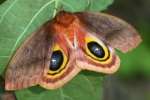 |
- Identification: Upperside occasionally males from the spring brood will be mostly brown. Female forewings are brown or brownish purple to red and the bands and eyespots may or may not be apparent. Hindwings of both sexes are yellow to brownish orange with yellow or orange margins. Each hindwing has a large black and blue eyespot with a white dash in the middle.
- Life history: Adults emerge during late morning or early afternoon, and mating takes place in the late evening. Females lay clumps of eggs on leaves or stems of the host plants. Young caterpillars feed together as a group and move in long "trains" while older caterpillars feed alone. Papery cocoons are spun in litter under the host plant or in crevices.
- Flight: One brood in the north from May-June, two to three broods in the south from February-September, several broods throughout the year in the Florida Keys.
- Wing span: 2 - 3 1/8 inches (5 - 8 cm).
- Caterpillar hosts: A variety of plants including hackberry (Celtis), willow (Salix), mesquite (Prosopis), redbud (Cercis), currant (Ribes), blackberry (Rubus), and pear (Pyrus).
- Adult food: Adults do not feed.
- Habitat: Deciduous forests, thorn scrub, and suburban areas.
- Range: Maine west across southern Canada to southeastern Manitoba, the Dakotas, Nebraska, and Colorado; south to the Florida Keys, the Gulf states, Texas, and New Mexico; Mexico south to Costa Rico.

|
|
Juniper-twig Geometer Moth
Patalene olyzonaria
Superfamily: Geometroidea
Family: Geometridae Geometrid Moths
Subfamily: Ennominae
Tribe: Ourapterygini
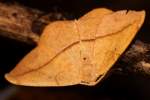
|
|
|
Large Paectes Moth
Paectes abrostoloidesa
Superfamily: Noctuoidea
Family: Noctuidae Owlet Moths
Subfamily: Amphipyrinae
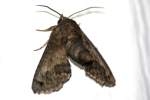
|
 |
|
Large Purplish Gray Moth
Iridopsis vellivolata
Superfamily: Geometroidea
Family: Geometridae Geometrid Moths
Subfamily: Ennominae
Tribe: Boarmiini

|
|
Luna Moth
Actias luna
Superfamily: Bombycoidea
Family: Giant Silkworm and Royal Moths Saturniidae
Subfamily: Giant Silkworm Moths Saturniidae
Tribe: Saturniini
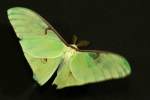 |
- Identification: Hindwings have long curving tails. Wings are pale green, each with a transparent eyespot. Outer margins are pink in the southern spring brood, yellow in the southern summer brood and in northern populations.
- Life history: Adults are very strong fliers and are attracted to lights. Mating takes place after midnight, and egg-laying begins that evening. Females lay eggs in small groups or singly on both surfaces of host plant leaves. The eggs hatch in about one week and the caterpillars are sedentary and solitary feeders. Leaves and silk are used to spin papery brown cocoons in litter under the host plant.
- Flight: One brood from May-July in the north, two to three broods from March-September in the south.
- Wing span: 2 15/16 - 4 1/8 inches (7.5 - 10.5 cm).
- Caterpillar hosts: A variety of trees including white birch (Betula papyrifera), persimmon (Diospyros virginiana), sweet gum (Liquidambar styraciflua), hickories (Carya), walnuts (Juglans), and sumacs (Rhus).
- Adult food: Adults do not feed.
- Habitat: Deciduous hardwood forests.
- Range: Common. Nova Scotia west to Saskatchewan and eastern North Dakota; south to central Florida, the Gulf Coast, and eastern Texas.
|
Many-lined Angle Moth
Macaria multilineata
Superfamily: Geometroidea
Family: Geometridae Geometrid Moths
Subfamily: Ennominae
Tribe: Semiothisini
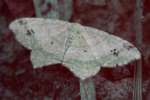 |
 |
|
Merry Melipotis Moth
Melipotis jucunda
Superfamily: Noctuoidea
Family: Erebidae
Subfamily: Erebinae
Tribe: Melipotini
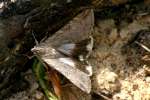
|
|
|
Nessus Sphinx
Amphion floridensis / A. nessus
Superfamily: Bombycoidea
Family: Sphinx Moths, Hawkmoths Sphingidae
Subfamily: Macroglossinae
Tribe: Macroglossini
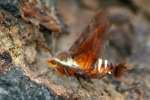
|
- Identification: Body is stout; abdomen has 2 bright yellow bands and a tuft at the end. Upperside of wings is dark red-brown. Hindwing has a red-orange median band and a yellow spot on the costal margin; in some moths the median band ranges from pale to almost absent.
- Life history: Adults fly during the day and at dusk. Caterpillars pupate in shallow underground chambers.
- Flight: . Several broods in Florida and Louisiana from February-September, two broods in coastal South Carolina from March-May and July-September, and one brood in New York and northward from April-July.
- Wing span: 1 7/16 - 2 3/16 inches (3.7 - 5.5 cm).
- Caterpillar hosts: Grape (Vitis), ampelopsis (Ampelopsis), and cayenne pepper (Capsicum).
- Adult food: Nectar from flowers including lilac (Syringa vulgaris), herbrobert (Geranium robertianum), beauty bush (Kolkwitzia amabilis), mock orange (Philadelphus coronarius), and Phlox.
- Habitat: Forests, streamsides, and suburbs.
- Range: Nova Scotia and Maine south to south Florida; west to Wisconsin, Nebraska, Colorado, and Texas.

|
Orange-tipped Oakworm Moth
Anisota senatoria
Superfamily: Bombycoidea
Family: Giant Silkworm and Royal Moths / Wild Silk Moths Saturniidae
Subfamily: Royal Moths Ceratocampinae
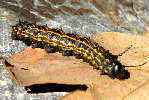 |
- Identification: Females can be twice as large as males. Upperside of female is yellow-orange to yellow-brown; forewing has a white cell spot and varying amounts of scattered black specks. Upperside of male is reddish orange to brownish orange; forewing is narrow with a small white cell spot and a small whitish translucent patch.
- Life history: Adults are day fliers. Mating takes place from late morning to early afternoon, and in late afternoon or dusk, females begin laying eggs in large clumps on the underside of oak leaves. Eggs hatch in about 2 weeks and are gregarious when young. Fully-grown caterpillars pupate and overwinter in shallow underground chambers.
- Flight: One brood from June-July.
- Wing span: 1 3/16 - 2 inches (3 - 5 cm).
- Caterpillar hosts: Various oaks (Quercus) and perhaps chinquapin (Castanea pumila).
- Adult food: Adults do not feed.
- Habitat: Deciduous forests.
- Range: Southern Maine west across the Great Lakes region to central Minnesota; south to central Georgia, central Alabama, central Mississippi, Louisiana, and east Texas.
|
Regal Moth / Royal Walnut Moth
Superfamily: Bombycoidea
Family: Giant Silkworm and Royal Moths Saturniidae
Subfamily: Ceratocampinae
Tribe: Hemileucini
Citheronia regalis
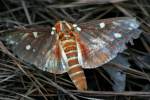 |
- Identification: Females are larger than males. Upperside of forewing is gray with red-orange veins and creamy yellow spots. Upperside of hindwing is orange with creamy yellow at the costa and inner margin.
- Life history: Adults emerge in late evening and mate the following evening. Females begin laying eggs at dusk the next day, depositing them in groups of 1-3 on both sides of host plant leaves. Eggs hatch within 6-10 days, and the caterpillars feed alone. Young caterpillars rest on the tops of leaves and resemble bird droppings, while older caterpillars appear menacing because they are very large and brightly colored with red "horns" near the head. Caterpillars pupate in a burrow in the soil.
- Flight: One brood from May through mid-September.
- Wing span: 3 15/16 - 6 1/4 inches (10 - 16 cm).
- Caterpillar hosts: Hickories (Carya), pecan (C. illinoensis), butternut (Juglans cinerea), black walnut (J. nigra), sweet gum (Liquidambar styraciflua), persimmon (Diospyros virginiana), sumacs (Rhus), cultivated cotton (Gossypium), and others.
- Adult food: Adults do not feed.
- Habitat: Deciduous woods.
- Range: New York west through southern Michigan and Illinois to eastern Kansas; south to central Florida, the Gulf states, and east Texas.
|
|
Reticulated Sparganothis Moth
Sparganothis reticulatana
Superfamily: Tortricoidea
Family: Tortricid Moths Tortricidae
Subfamily: Tortricinae
Tribe: Sparganothidini
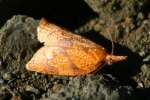
|
 |
Spiny Oakworm Moth
Anisota stigma
Superfamily: Bombycoidea
Family: Giant Silkworm and Royal Moths / Wild Silk Moths Saturniidae
Subfamily: Royal Moths Ceratocampinae
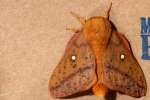
|
- Identification: Females are larger than males. Upperside is reddish orange with scattered small black specks and faint postmedian lines on both wings. Forewing has a small white cell spot. Males are redder than females. Texas individuals of both sexes are browner.
- Life history: Eggs are laid in clusters of 5-20 and hatch in about 2 weeks. Young caterpillars feed together and when older they feed alone. Fully-grown caterpillars pupate and overwinter in underground chambers.
- Flight: One brood; from June-July in the north, July-August in the south, and August-September in Texas.
- Wing span: 1 9/16 - 2 3/4 inches (4 - 7 cm).
- Caterpillar hosts: Various oaks (Quercus species).
- Adult food: Adults do not feed.
- Habitat: Deciduous woods.
- Range: Southeastern Canada; southern New England west to Minnesota, south to central Florida, the Gulf Coast, and central Texas.
|
Three-lined Flower Moth
Schinia trifascia
Superfamily: Noctuoidea
Family: Owlet Moths, Miller Moths Noctuidae
Subfamily: Heliothentine Noctuids, Flower Moths Heliothentinae
 |
|
Variable Tropic Moth
Hemeroplanis scopulepes
Superfamily: Noctuoidea
Family: Owlet Moths, Miller Moths Noctuidae
Subfamily: Catocaline Noctuid Moths Catocalinae
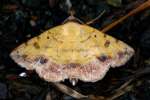 |
|
|
Virginia Creeper Sphinx Moth
Darapsa myron
Superfamily: Bombycoidea
Family: Sphingidae - Sphinx Moths, Hawkmoths
Subfamily: Macroglossinae
Tribe: Macroglossini

|
|
|
White-lined Sphinx Moth
Hyles lineata
Superfamily: Bombycoidea
Family: Sphingidae - Sphinx Moths, Hawkmoths
Subfamily: Macroglossinae
Tribe: Macroglossini
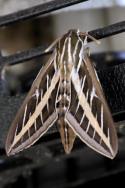
|
|
| Information / Identification Sources: |
For identification our primary reference is Moths of Eastern North America - Roger Tory Peterson Field Guides - by Charles P. Covell, Jr. (out of print and hard to get!). We also use internet sources when in question - typically BugGuide. Our text information (above, where we have it) comes from Butterflies & Moths of North America. |
| |
 |


